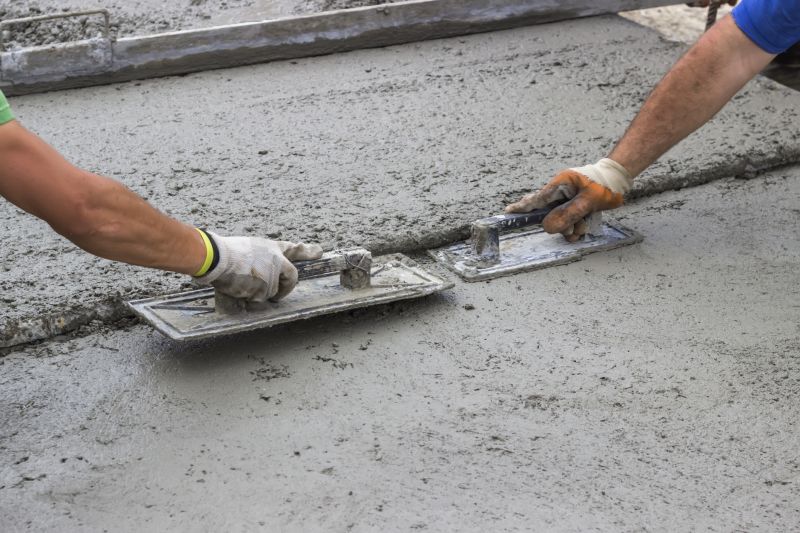Leading Selection Of Concrete Installation Products For Every Skill Level
Whether you're a beginner or a pro, find essential products to support your concrete installation needs with confidence.
 Concrete installations are a fundamental aspect of many construction and renovation projects in Olathe, KS. From residential driveways to commercial flooring, selecting the right products ensures durability, safety, and aesthetic appeal. Proper preparation and the right tools can significantly influence the quality of the finished concrete surface. Whether you're pouring a new slab, repairing an existing surface, or installing decorative features, understanding the variety of products available is essential for achieving optimal results.
Concrete installations are a fundamental aspect of many construction and renovation projects in Olathe, KS. From residential driveways to commercial flooring, selecting the right products ensures durability, safety, and aesthetic appeal. Proper preparation and the right tools can significantly influence the quality of the finished concrete surface. Whether you're pouring a new slab, repairing an existing surface, or installing decorative features, understanding the variety of products available is essential for achieving optimal results.
Top Overall Option
Versatile Concrete Form System
A comprehensive concrete form system provides adjustable, reusable forms that facilitate precise shaping of slabs, walls, and other structures. Its durability and ease of setup make it suitable for a wide range of projects, ensuring consistent results and efficient workflow.
Types of Products For Concrete Installations
Concrete Forms
Reusable molds used to shape poured concrete into desired structures, available in various sizes and configurations.
Reinforcement Mesh
Metal or fiber mesh used to strengthen concrete and reduce cracking.
Concrete Mixes
Pre-mixed or custom blends formulated for specific strength and setting time requirements.
Bonding Agents
Adhesives applied between old and new concrete surfaces to improve adhesion.
Curing Compounds
Liquid coatings that retain moisture and promote proper curing of concrete.
Sealants and Waterproofers
Products designed to protect concrete surfaces from water penetration and staining.
Concrete Edging Tools
Tools used to create clean, defined edges for slabs and walkways.
Surface Finishing Tools
Trowels, floats, and brushes used to achieve smooth or textured finishes.
Expansion Joints
Materials that allow for movement within concrete slabs, reducing cracking.
Vibrators
Equipment used to eliminate air pockets and consolidate concrete during pouring.
Concrete Repair Patches
Products formulated to fill cracks and damaged areas in existing concrete.
Anti-Freeze Additives
Additives that enable concrete to set properly in cold weather conditions.
Color Additives
Pigments and dyes used to add color to concrete surfaces.
Form Release Agents
Products applied to molds to facilitate easy removal without damaging the form.
Grout and Anchors
Materials used to secure fixtures or embed objects within concrete.
Fiber Reinforcements
Synthetic or steel fibers added to concrete to improve tensile strength.
Popular Choices
Widely used to ensure proper compaction and reduce voids during pours.
Commonly selected to enhance structural integrity of slabs.
Popular for protecting surfaces from stains and water damage.
Frequently used to facilitate easy removal of forms after curing.
Preferred for maintaining moisture during curing, especially in dry conditions.
Chosen for decorative concrete projects to add vibrant hues.
Commonly installed to prevent cracking in large slabs.
Popular for creating clean, professional-looking borders.
Widely used to achieve smooth, polished finishes.
Often selected for projects in colder months to ensure proper setting.
Frequently used for quick fixes and surface restoration.
Popular for enhancing tensile strength in concrete slabs.
Commonly applied to improve adhesion between old and new concrete surfaces.
Chosen to protect concrete foundations and basements.
Standard for creating precise shapes and edges in concrete projects.
Essential for ensuring proper compaction during large pours.
Concrete installation projects often require a combination of products tailored to specific needs. These include forms to shape the concrete, reinforcement materials to add strength, and finishing tools to achieve the desired surface texture. Additionally, curing compounds and sealers help protect the concrete during the curing process and extend the lifespan of the installation. Proper selection and application of these products can help mitigate common issues such as cracking, uneven surfaces, or premature wear.
In Olathe, KS, where weather conditions can vary, choosing products suited for local climate conditions is particularly important. High-quality additives and sealers can help protect against moisture intrusion and temperature fluctuations. For large-scale projects, professional-grade equipment and materials may be necessary to ensure safety and compliance with local building codes. Whether you are a DIY enthusiast or a professional contractor, understanding the range of available products can aid in planning and executing successful concrete installations.
Investing in the right products not only facilitates a smoother installation process but also contributes to the longevity and appearance of the finished project. From basic tools to advanced reinforcement systems, the right selection can make a significant difference. Always consider the specific requirements of your project, including load-bearing needs, aesthetic goals, and environmental conditions, to choose products that best suit your needs.
Key Buying Considerations
- Determine the specific type of concrete project to identify suitable products.
- Consider environmental conditions such as temperature and humidity during installation.
- Assess the load-bearing requirements to select appropriate reinforcement materials.
- Evaluate the size and scope of the project to determine quantity and scale of products needed.
- Check compatibility of bonding agents and sealers with existing surfaces.
- Choose products that facilitate ease of use and application, especially for DIY projects.
- Review product curing times to align with project timelines.
- Ensure products meet local building codes and safety standards.
- Consider the durability and longevity of materials in the context of the project's expected lifespan.
- Select finishing tools that match the desired surface texture and appearance.
- Pay attention to product compatibility to avoid adverse reactions or poor adhesion.
- Opt for high-quality, reputable brands to ensure consistent performance.
- Factor in cost-effectiveness by balancing quality and budget constraints.
- Research product reviews and user feedback for insights on performance.
- Plan for weather protection measures if working outdoors in variable conditions.
